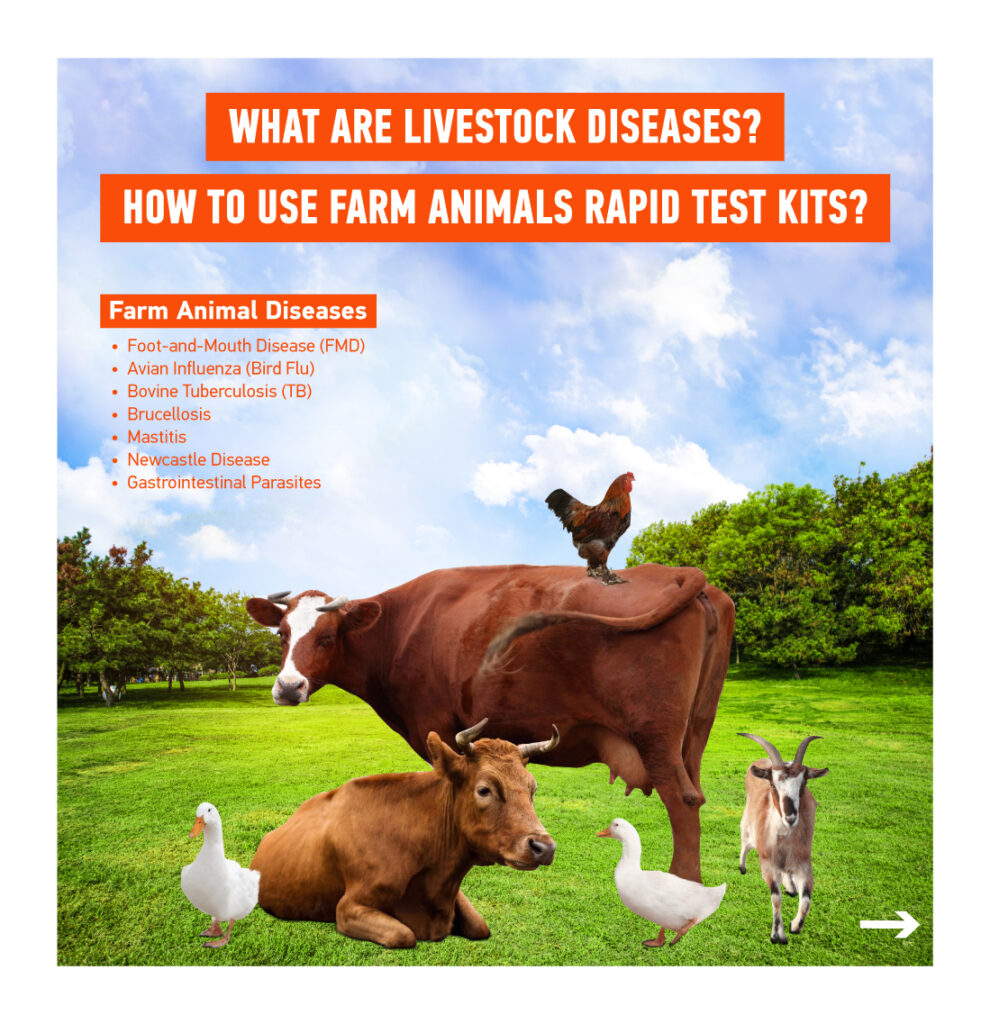Livestock farming is a vital component of the global agricultural industry, providing us with essential products like meat, dairy, and eggs. However, livestock are susceptible to various livestock diseases that can have a significant impact on both animal welfare and farm productivity. In this blog, we will explore what livestock diseases are, their consequences, and how farm animal rapid test kits can help in their early detection and management.
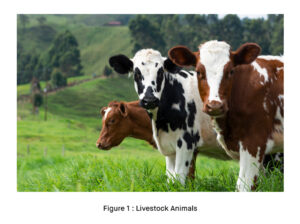
Understanding Livestock Diseases: Threats to Animals, Economics, and Public Health
Livestock diseases are illnesses that affect animals raised for agricultural purposes, such as cattle, sheep, goats, poultry, pigs, and other farm animals [1]. These diseases can be caused by various pathogens, including bacteria, viruses, parasites, fungi, and in some cases, nutritional deficiencies [1]. Livestock diseases can have significant economic, public health, and animal welfare implications. Here are some key aspects of livestock diseases:
Economic Impact: Livestock diseases can lead to reduced productivity, increased veterinary expenses, and economic losses for farmers. Infected animals may produce less milk, meat, or eggs, and in some cases, entire herds or flocks may need to be culled to prevent disease spread [2].
Animal Welfare: Livestock diseases can cause suffering and discomfort to animals. Ensuring the health and well-being of farm animals is an ethical responsibility for farmers and animal welfare organizations.
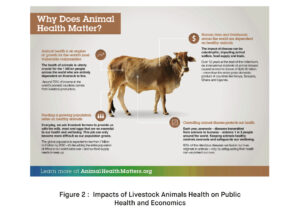
Food Safety: Some livestock diseases have zoonotic potential, which means they can be transmitted from animals to humans [2]. Ensuring that livestock are free from certain diseases is essential for food safety and preventing the spread of diseases to consumers.
Public Health: Diseases that affect livestock can have public health implications if they can be transmitted to humans. For example, avian influenza (bird flu) and bovine tuberculosis (TB) are examples of diseases that have raised concerns about human transmission [3].
Global Trade: The presence of certain livestock diseases in a region can impact international trade in animal products. Many countries have strict regulations regarding the import and export of livestock and livestock products to prevent the spread of diseases.
What are The Most Common Livestock Diseases?
Common examples of livestock diseases include:
Foot-and-Mouth Disease (FMD)
Foot-and-Mouth Disease (FMD) is a highly contagious viral illness affecting cloven-hoofed animals like cattle, pigs, sheep, and goats [3]. The FMD virus (FMDV) is responsible, with multiple serotypes and subtypes complicating control. It spreads through direct and indirect contact, as well as airborne transmission, causing fever, vesicles, lameness, drooling, and reduced productivity in animals [4]. FMD has severe economic consequences, impacting milk and meat production, triggering trade restrictions, and occasionally causing mild human infections. Control involves vaccination, quarantine, biosecurity, and culling in severe cases. Despite eradication successes in some areas, ongoing vigilance is necessary due to its contagiousness.
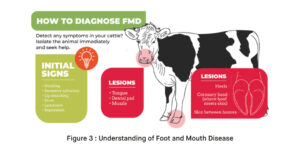
Avian Influenza (Bird Flu)
Avian Influenza, or Bird Flu, primarily affects birds, including poultry like chickens, ducks, and turkeys. Some strains can also infect humans, posing public health concerns. It’s caused by influenza A viruses with various subtypes like H5N1 and H7N9 [5]. Transmission occurs through contact with infected birds or their environment, and rarely, by consuming undercooked poultry [5]. Avian influenza can harm birds by reducing egg production or causing high mortality rates [5]. In humans, it causes severe but infrequent infections similar to regular influenza. The risk of genetic reassortment with human influenza viruses necessitates strict control, including culling infected birds, vaccination, surveillance of wild birds, and pandemic preparedness.
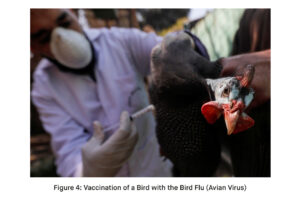
Bovine Tuberculosis (TB)
Bovine Tuberculosis (TB) is caused by Mycobacterium bovis, primarily affecting cattle but also capable of infecting other animals and, rarely, humans. It spreads through close contact, ingestion of contaminated materials, and environmental exposure [3]. Infected cattle may show symptoms like coughing, weight loss, and reduced milk production. While primarily an animal disease, it can infect humans, especially through unpasteurized dairy. It has economic implications, affecting livestock productivity and trade. Control measures include testing, quarantine, culling, biosecurity, and pasteurization. Globally, efforts aim to control and eradicate Bovine TB through surveillance and control programs, supported by diagnostic tests. Addressing this issue is crucial for animal and human health and the livestock industry’s economic stability.
Brucellosis
Brucellosis, caused by various Brucella bacteria species, affects animals and humans through multiple transmission routes. Animals may experience symptoms like abortion and reduced fertility, while humans may develop fever and joint pain. This disease has economic consequences for livestock industries, leading to control measures such as vaccination, testing, culling, pasteurization, and biosecurity practices. Global coordination is vital due to its wide host range and zoonotic nature. Diagnosis involves serological tests and bacterial culture. Brucellosis remains a significant public health concern, requiring ongoing control and awareness efforts.
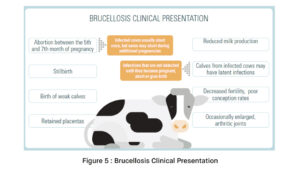
Mastitis
Mastitis in dairy cows, an economically impactful infectious disease, results in udder inflammation, diminished milk quality, and welfare concerns [6]. Key points include multiple causative agents, such as bacteria, fungi, and viruses, with common pathogens like Staphylococcus aureus [6]. Transmission occurs during milking or due to unhygienic conditions. Clinical signs encompass udder swelling, abnormal milk, reduced production, and general illness symptoms [6]. Mastitis is categorized into clinical and subclinical forms, impacting milk yield. Its economic implications involve treatment costs, reduced milk output, and potential culling. Prevention strategies encompass hygiene, milking procedures, antibiotics, vaccination, and culling. Regular monitoring aids early detection, and timely intervention is vital for animal welfare and dairy industry sustainability.
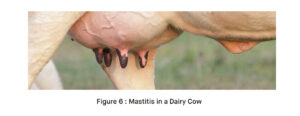 Newcastle Disease
Newcastle Disease
Highly contagious in poultry, is caused by the Newcastle disease virus (NDV). It spreads through direct contact, contaminated items, and respiratory secretions, causing varied symptoms in birds, from respiratory and digestive signs to nervous system issues, reduced egg production, and high mortality. This disease carries economic consequences for the poultry industry due to decreased egg production, increased mortality, and trade restrictions. While it primarily affects birds, some strains can cause mild conjunctivitis in humans. Control involves vaccination, strict biosecurity, quarantine, and culling during severe outbreaks. Global surveillance and vaccination efforts are crucial for containment.
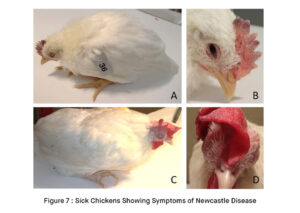
Gastrointestinal Parasites
Gastrointestinal parasites, diverse microorganisms inhabiting animals’ digestive tracts, pose health risks. They’re categorized into helminths (worms), protozoa, and ectoparasites. Transmission occurs through contaminated food, water, or contact with infected animals or feces, and some can penetrate the skin. Symptoms vary but often include diarrhea, abdominal discomfort, weight loss, and anemia. Diagnosis involves stool sample examination, while treatment employs antiparasitic medications. Prevention includes hygiene, proper food preparation, deworming, and sanitation. These parasites can impact health, especially in vulnerable populations, making control measures crucial for global public health.
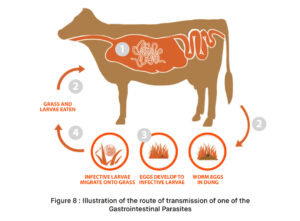
Preventing and managing livestock diseases involves practices such as vaccination, quarantine, biosecurity measures, regular veterinary care, and, in some cases, the use of diagnostic tests like rapid test kits to detect diseases early. Effective disease control is essential for maintaining animal health, ensuring food safety, and sustaining the livestock industry.
Rapid Diagnostic Test Kits for Critical Livestock Diseases and How to Use Farm Animals Rapid Test Kits?
The B. Brucella Ab Rapid Test Kit
The B. Brucella Ab Rapid Test Kit is a lateral flow immunoassay designed for the rapid and qualitative detection of antibodies against Brucella abortus in bovine serum or plasma samples. Brucellosis, commonly referred to as Bang disease, is a prevalent cause of abortions in cattle. Infections can also lead to outcomes such as stillborn or weak calves, retained placentas, and decreased milk production.
Our B. Brucella Ab Rapid Test Kit offers a fast, accurate, and cost-effective tool to assist veterinary professionals in diagnosing Brucellosis. This can be instrumental in preventing further transmission of the disease, reducing the risk of zoonotic transmission to humans, and alleviating the overall impact of Brucellosis in cattle populations.
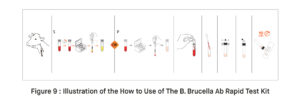
The M. Tuberculosis Ab Rapid Test Kit
The M. Tuberculosis Ab Rapid Test Kit is a lateral flow immunoassay designed for the rapid and qualitative detection of antibodies against bovine tuberculosis (TB) in bovine serum or plasma samples. Bovine Tuberculosis is a significant and contagious bacterial infection that affects various animal species in farms, wildlife, and can also infect humans. Common symptoms include lactation problems, loss of appetite, breathing difficulties, diarrhea, and weight loss. As there is currently no definitive cure for TB in cattle, infected animals are typically culled to prevent the spread of the disease. Timely diagnosis is crucial for containing its transmission.
Our M. Tuberculosis Ab Rapid Test Kit offers a fast, accurate, and cost-effective means to aid veterinary professionals in diagnosing bovine tuberculosis. This can play a pivotal role in preventing further disease transmission and reducing the overall impact of TB in cattle populations.
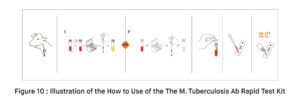
The FMDV Ab Rapid Test Kit
The FMDV Ab Rapid Test Kit is a diagnostic tool designed to detect antibodies against the Foot-and-Mouth Disease Virus in the blood of animals. These antibodies are produced by the animal’s immune system in response to infection with the virus. Rapid test kits are used by veterinarians and animal health professionals to quickly screen animals for the presence of FMDV antibodies, which can help in the early detection of the disease and implementation of control measures.
The Avian Influenza Ag Rapid Test Kit
The Avian Influenza Ag Rapid Test Kit is a diagnostic tool designed to detect the presence of antigens associated with Avian Influenza (bird flu) in birds and poultry. Avian Influenza is a highly contagious viral infection that primarily affects birds, including chickens, ducks, and turkeys, but it can occasionally infect humans and other animals. Rapid test kits for Avian Influenza are used primarily in the poultry industry and by veterinarians to quickly and accurately diagnose the presence of the virus in bird populations.
The NDV Ag Rapid Test Kit
The NDV Ag Rapid Test Kit is a diagnostic tool designed to detect the presence of Newcastle Disease Virus (NDV) antigens in birds, especially poultry. Newcastle Disease is a highly contagious viral infection that affects a wide range of bird species, including chickens, turkeys, and other domestic and wild birds. Rapid test kits for NDV are used in the poultry industry and by veterinarians to quickly and accurately diagnose the presence of the virus in bird populations.
Newcastle Disease can also have a significant impact on international trade of poultry and poultry products, so accurate and rapid testing is essential for ensuring compliance with trade regulations and maintaining the health of bird populations.
REFERENCES
[1] Huntington, B., Bernardo, T. M., Bondad-Reantaso, M., Bruce, M., Devleesschauwer, B., Gilbert, W., … & Rushton, J. (2021). Global Burden of Animal Diseases: a novel approach to understanding and managing disease in livestock and aquaculture. REVUE SCIENTIFIQUE ET TECHNIQUE-OFFICE INTERNATIONAL DES EPIZOOTIES, 40(2), 567-583.
[2] Perry, B. D., Grace, D., & Sones, K. (2013). Current drivers and future directions of global livestock disease dynamics. Proceedings of the National Academy of Sciences, 110(52), 20871-20877.
[3] Tomley, F. M., & Shirley, M. W. (2009). Livestock infectious diseases and zoonoses. Philosophical Transactions of the Royal Society B: Biological Sciences, 364(1530), 2637-2642.
[4] Jamal, S. M., & Belsham, G. J. (2013). Foot-and-mouth disease: past, present and future. Veterinary research, 44, 1-14.
[5] Lycett, S. J., Duchatel, F., & Digard, P. (2019). A brief history of bird flu. Philosophical Transactions of the Royal Society B, 374(1775), 20180257.
[6] Ruegg, P. L., & Petersson-Wolfe, C. S. (2018). Mastitis in dairy cows. Veterinary Clinics: Food Animal Practice, 34(3), ix-x.
